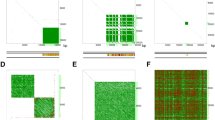Abstract.
The physical ends of chromosomes are protected and stabilised by telomeres. The sequence of telomeric DNA normally consists of a simple repeating unit that is conserved in many organisms. Most plants examined have been shown to possess Arabidopsis-type telomeres consisting of many repeat copies of the sequence 5′-TTTAGGG-3′. Using fluorescent in situ hybridisation, slot blotting and the asymmetric polymerase chain reaction we demonstrate an absence of Arabidopsis-type telomeres in the genus Aloe (family Asphodelaceae). The only other plant genera so far reported without such telomeres are Allium, Nothoscordum, and Tulbaghia (family Alliaceae). As these genera and Aloe are petaloid monocots in the Asparagales, it is suggested that an absence of Arabidopsis-type telomeres may be characteristic of this related group of plants.
Similar content being viewed by others
Author information
Authors and Affiliations
Additional information
Received: 6 September 1999; in revised form: 9 December 1999 / Accepted: 13 December 1999
Rights and permissions
About this article
Cite this article
Adams, S., Leitch, I., Bennett, M. et al. Aloe L. – a second plant family without (TTTAGGG)n telomeres. Chromosoma 109, 201–205 (2000). https://doi.org/10.1007/s004120050429
Issue Date:
DOI: https://doi.org/10.1007/s004120050429




